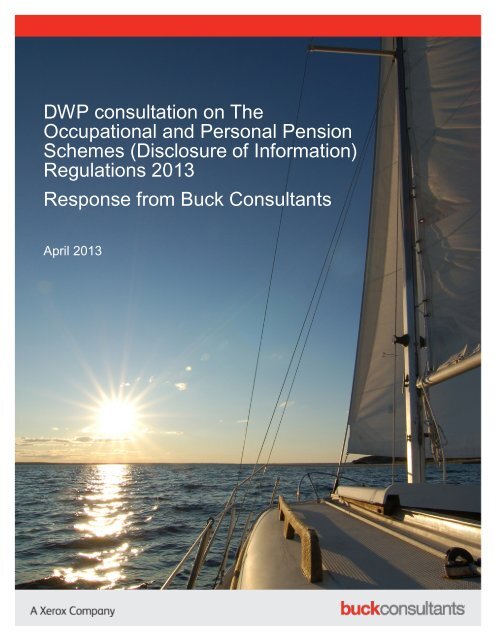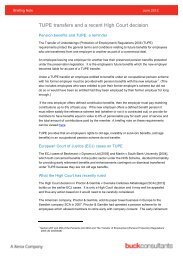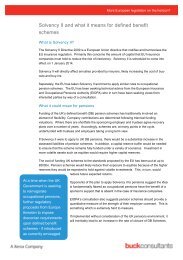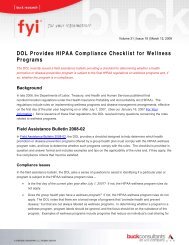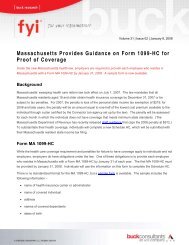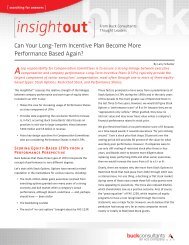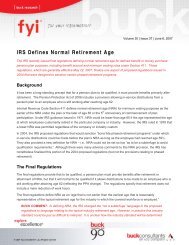Disclosure of Information - Buckconsultants.com
Disclosure of Information - Buckconsultants.com
Disclosure of Information - Buckconsultants.com
- No tags were found...
You also want an ePaper? Increase the reach of your titles
YUMPU automatically turns print PDFs into web optimized ePapers that Google loves.
DWP consultation on TheOccupational and Personal PensionSchemes (<strong>Disclosure</strong> <strong>of</strong> <strong>Information</strong>)Regulations 2013Response from Buck ConsultantsApril 2013
Buck Consultants: <strong>Disclosure</strong> <strong>of</strong> information regulationsIntroduction and executive summaryWe are pleased to be able to respond to this very important consultation exercise. As theconsultation paper correctly identifies, there are problems with the current statutory disclosurerequirements, in the following areas:• They are spread across several places and it can be difficult for administrators toensure that they have identified and satisfied all the requirements.• Requirements are separately formulated for personal pensions, occupational pensionsand stakeholder schemes, and there are overlaps and inconsistencies both betweenand within the categories.• In a number <strong>of</strong> cases they are too prescriptive, hampering administrators’ desire tomake them more relevant and accessible to recipients and consequently failing in theirobjective <strong>of</strong> providing necessary and appropriate information to members.Effective disclosure <strong>of</strong> information about benefits and options is <strong>of</strong> great importance in anypension arrangement; in one where the member is expected to take a number <strong>of</strong> difficultdecisions over a long time period that will determine his financial security in retirement it iscrucial. The widespread move to defined contribution arrangements has therefore increased theimportance <strong>of</strong> effective member <strong>com</strong>munication, and the advent <strong>of</strong> automatic enrolment is likelyto expose a significantly greater number <strong>of</strong> new members to pensions. It is therefore importantthat required changes are implemented as soon as possible, to cater for these new members.But the pensions world is changing again, and new scheme designs are on the horizon, partlyas a result <strong>of</strong> the “defined ambition” initiative. One measure <strong>of</strong> the success <strong>of</strong> the initiative willbe the emergence and adoption <strong>of</strong> new scheme designs, many <strong>of</strong> which will blend aspects <strong>of</strong>both defined benefit and defined contribution concepts. Not all <strong>of</strong> these new designs will fiteasily into the current categorisation for disclosure purposes. Many will challenge currentthinking on the way schemes should work, and will require new approaches to <strong>com</strong>municationto and from members.This implies the need for a flexibility <strong>of</strong> approach that is difficult to achieve with prescriptiveregulations that set out requirements in micro detail. Consequently, whilst we recognise the stepforward that the draft 2013 regulations represent over the current regulations, we consider thatthey do not go far enough in establishing an information environment that properly supports andenhances a “DA future”. To achieve that, we believe that the solution lies with a principlesbasedapproach which will give freedom for individual schemes to design information systemsthat match the needs <strong>of</strong> them and their members. In making this re<strong>com</strong>mendation, we fullyappreciate the difficulties that ac<strong>com</strong>pany such an approach – such as the need for greaterlevels <strong>of</strong> interpretation and therefore less certainty in particular cases <strong>of</strong> whether therequirements have been <strong>com</strong>plied with, and the increased risk that inconsistencies inapproaches will result in less clarity overall for members – but we think that the very flexibility <strong>of</strong>2
Buck Consultants: <strong>Disclosure</strong> <strong>of</strong> information regulationssuch an environment will allow schemes to adapt accordingly to address such problems.Furthermore, if the principles were to be backed by formal guidance, developed in associationwith, and eventually owned and managed by, the pensions industry, any uncertainties should bemanageable; a template for such joint development and ownership might be the industry codeon incentive exercises.Responses to the consultation questions1. Do you agree these amendments meet the overall aims?As mentioned above, we consider that the amendments are an improvement on the currentposition, and so to that extent they do go some way to meeting the four aims listed in theconsultation document. However, they are less successful in respect specifically <strong>of</strong> the fourthaim – that <strong>of</strong> fitting with the changing pension landscape and overall workplace pension reformagenda. We set out our views on how to address that issue in question 15.Nevertheless, given the time it will apparently take to develop a new principles-based approach(on the evidence <strong>of</strong> the pace <strong>of</strong> progress to date) the amendments introduced by the proposed2013 regulations are a useful interim step and are therefore largely wel<strong>com</strong>e.There is one specific addition to the regulations that would assist in their meeting the overallaims. There has been at least one determination made by the Pensions Ombudsman where ascheme administrator has been criticised for not performing an activity within a timeframedeemed appropriate by the Ombudsman, but where that timeframe was nevertheless within theappropriate statutory time limit set out in the disclosure regulations. This has created legaluncertainty around the issue <strong>of</strong> disclosure time limits.If the regulations are to continue to specify time limits, they should contain a clear statementthat provided the action is performed within the timeframe specified in the regulations, the partyresponsible for performing the action will not be subject to a determination from the PensionsOmbudsman.2. Do you foresee any problems with these regulations <strong>com</strong>ing into force in October2013, particularly relating to the new provision on lifestyling?From one perspective, the proposed timing is a long way short <strong>of</strong> perfect. Providers, schemesand their sponsoring employers are currently having to cope with a heavy workload <strong>of</strong> newrequirements. Probably the largest single item is automatic enrolment, which after a gentle startis set to gather pace from autumn 2013 – just as the new disclosure regulations <strong>com</strong>e into force.It is unfortunate that the disclosure changes have taken so long to develop.However, we have to set against that the potential benefits from the changes the regulations willintroduce – particularly in respect <strong>of</strong> defined contribution schemes, to which the new lifestylingrequirements will apply. These schemes will almost certainly be the most prevalent type to be3
Buck Consultants: <strong>Disclosure</strong> <strong>of</strong> information regulationsused for automatic enrolment and we endorse the principle that they must be as transparentand member-friendly as possible in order to keep opt-out rates to a minimum.Realistically the pace <strong>of</strong> change and the need for pension schemes to react accordingly isunlikely to abate any time soon. As an industry we are sometimes guilty <strong>of</strong> using the longtimescale <strong>of</strong> pension accrual to justify deferring the introduction <strong>of</strong> changes that are neededurgently. The introduction <strong>of</strong> these regulations in October will place an additional burden onschemes and employers that will not be universally wel<strong>com</strong>ed; however, they are important andlong overdue, so the stronger case is for pressing ahead with the planned timetable.3. Do you agree with the scope <strong>of</strong> the consolidation?Yes broadly, as an interim measure pending the move to a principles-based system. However,there are items that could fall under the “disclosure” banner, scattered throughout pensionslegislation, and it could be helpful for some <strong>of</strong> those also to be consolidated under theseregulations. We recognise that the difficulty with this is that in many <strong>of</strong> these cases the provisionis merely a disclosure element <strong>of</strong> the bigger issue, such as in the pensions sharing on divorceregulations. In such cases one could make a case for the disclosure to be under either set <strong>of</strong>regulations.However, a guiding principle could be that where the disclosure element can be detached fromthe subject matter that it is disclosing about, it would more logically fall into the “own right”disclosure area, and where it is connected to another disclosure requirement that is in theseregulations, that it should more logically be placed into these regulations. The regulations are forthe use <strong>of</strong> those who run schemes rather than for the benefit <strong>of</strong> the members, so the location <strong>of</strong>the provisions should be where those people would logically expect to find them.4. Where our requirements duplicate FCA rules do you agree they should beremoved? If not, which provisions should be retained and why?As a point <strong>of</strong> principle, the requirements should not be duplicated. However, it might make theregulations a little more helpful to users trying to identify the full breadth <strong>of</strong> the disclosurerequirements that need to be met if there was a statement in the regulations reminding thatthere may be additional requirements imposed, and best practice guidelines re<strong>com</strong>mended, bya regulator; to future-pro<strong>of</strong> the regulations this should not just refer to the FCA (or the PensionsRegulator).Yes.5. Do you consider the new structure <strong>of</strong> the regulations to be a useful change?6. Do you think that any <strong>of</strong> the changes mentioned in this Chapter (3) will haveany unintended consequences?We have not identified any.4
Buck Consultants: <strong>Disclosure</strong> <strong>of</strong> information regulations7. Are you content with the changes we propose to make to the basic schemeinformation which schemes are required to disclose?Broadly, yes; however, see our <strong>com</strong>ments in question 8 on the lifestyling requirement.8. Do you agree that this requirement would be beneficial to members and thatthe wording <strong>of</strong> this requirement would cover all forms <strong>of</strong> lifestyling?We agree that it is important that members have as <strong>com</strong>plete an understanding <strong>of</strong> the aspects<strong>of</strong> their scheme as possible, including the investment media being used. Lifestyling, when it isavailable, is an important investment tool which in many cases is also the default option applied.Whilst for many members it is a “tick the box and forget” option, they should be reminded atstrategic points in their accrual phase <strong>of</strong> membership that they are in the lifestyling fund, andwhat that means in terms <strong>of</strong> steps being taken to change the pr<strong>of</strong>ile <strong>of</strong> the investments at certainpoints. If they have that knowledge, they have the option to intervene and change the processfrom the automatic one that would otherwise apply.However, the proposed disclosure requirement appears to be focused on the change that wouldoccur as the derisking phase on the approach to retirement begins; whilst we can see the logic<strong>of</strong> that, given the likely importance <strong>of</strong> lifestyling funds in the future, there will undoubtedly be arange <strong>of</strong> developments in fund designs, some <strong>of</strong> which may not yet be anticipated.We therefore think that the current wording is too narrow, and would question whether thegenerally-understood definition <strong>of</strong> lifestyling is as the regulations assume. We think the wordingwould be more effective if it were cast more as a principle to be followed in <strong>com</strong>municating withthe member at any time when the person or organisation running the scheme/appropriate fundis or should be aware that a change in the investment structure for that member in response toa forth<strong>com</strong>ing date or life event is about to occur. This should be closely tied in with theinformation given about the lifestyle fund, the way in which it operates and its effects, at thepoint <strong>of</strong> the member’s entry.9. Do you agree that the changes will allow schemes to provide morepersonalised statements?Yes – although the additional flexibility allowed is modest.10. Do you think changes need to be made to the timing <strong>of</strong> the first SMPI to takeaccount <strong>of</strong> the introduction <strong>of</strong> automatic enrolment? If so, what timing do youthink would be the most appropriate?5
Buck Consultants: <strong>Disclosure</strong> <strong>of</strong> information regulationsAs the consultation document observes, SMPIs are generally run for all members <strong>of</strong> a scheme,on one occasion each year. The determination <strong>of</strong> whether a new member should make the cutfor receiving an SMPI in that year should be on the basis <strong>of</strong> whether or not a contribution hasbeen paid irrevocably to the scheme – in other words the opt-out window in respect <strong>of</strong> the firstyear’s membership has closed.11. Do you think the regulations allow for concise statements? If not whichelements <strong>of</strong> the regulations prevent this?Yes, it ought to be possible to limit a statement to 2 or 3 pages at most and still <strong>com</strong>ply with theregulations. However, as far as the headline points are concerned, we think the target should beto provide the key information on one sheet. That can be achieved by relegating all <strong>of</strong> thebackground detail to a generic document or webpage, and providing a cross-reference or link toit from the SMPI. Our interpretation <strong>of</strong> these regulations is that this should not be prohibited bythem.Yes.12. Are you content with the proposed changes in relation to electronic forms <strong>of</strong><strong>com</strong>munication?13. The existing regulations require certain information (such as the constitution<strong>of</strong> the scheme) to be available for inspection at a reasonable location. Doyou consider that this method <strong>of</strong> <strong>com</strong>munication is still appropriate given theavailability <strong>of</strong> electronic <strong>com</strong>munication?It is still the case that not everybody has access to electronic <strong>com</strong>munication facilities, and so tocater for those, there should still be an option for inspection <strong>of</strong> a hardcopy. However, it would bereasonable for scheme managers to be given the discretion to determine whether it isnecessary to make a hard copy available in the case <strong>of</strong> their scheme, given their knowledge <strong>of</strong>their members.14. Do you consider that all the appropriate legislation has been included in thedraft regulations?See our answer to question 3.15. Would you wel<strong>com</strong>e further consideration <strong>of</strong> a “principles based” approach tothe disclosure <strong>of</strong> information as outlined in the 2009 consultation?Yes. One <strong>of</strong> the factors that has restricted the overall effectiveness <strong>of</strong> workplace pensions in theUK has been the polarisation <strong>of</strong> scheme designs, under (largely final salary) DB and DC. Withinsuch narrow parameters it is possible (although, we would argue, still undesirable) to operate asystem that prescribes exactly what when and how needs to be <strong>com</strong>municated to members.6
Buck Consultants: <strong>Disclosure</strong> <strong>of</strong> information regulationsWith the prospect <strong>of</strong> a larger variety <strong>of</strong> designs and variations emerging under the definedambition banner, the potential for a prescriptive system to grow out <strong>of</strong> control and/or to holdback innovation increases significantly. The most effective way <strong>of</strong> addressing these issues is toemploy a principles-based system.We fully appreciate that one implication <strong>of</strong> such a system is that it is more difficult for a regulatorto ensure that appropriate standards and a consistency <strong>of</strong> approach are maintained. Arguablythis was one <strong>of</strong> the drivers <strong>of</strong> the prescriptive approach originally adopted for disclosurerequirements in the 1986 regulations. However, before that time there were no particularrequirements, and standards <strong>of</strong> disclosure were varied. Following the introduction <strong>of</strong> theregulations, the focus was <strong>of</strong>ten more on satisfying the letter <strong>of</strong> the regulations rather thanmaking sure they <strong>com</strong>municated effectively with members.Today the environment is different, and overall standards higher, with the effectiveness <strong>of</strong> themessage widely recognised as being key. There should be less need for a prescriptive, “handson”regulatory approach.As for the concerns amongst those managing schemes that a principles-based approach affordsless certainty as to what will satisfy the regulatory requirements, this can be addressed to acertain extent by formal guidance, issued by the appropriate regulator.This area might be one which would benefit from an approach similar to that employed forincentive exercises, where a code has been developed jointly between the DWP and thepensions industry and is now owned by the industry, with most <strong>of</strong> the industry having signed upin support <strong>of</strong> it.About Buck ConsultantsBuck Consultants is a leading actuarial, pensions and employee benefits consultancy. We helporganisations develop, deploy and manage their workforce by providing real-world solutions toour clients, including retirement services, health and productivity programmes, and effectiveemployee <strong>com</strong>munications.Our pension and employee benefit pr<strong>of</strong>essionals specialise in:• Actuarial services• Administration• Auto-enrolment• Communication• Flexible benefits• Healthcare and risk insurances• Investment consulting7
Buck Consultants: <strong>Disclosure</strong> <strong>of</strong> information regulations• Pension consultingFrom our modest beginnings in 1916, we now employ over 1,500 pr<strong>of</strong>essionals and affiliates inover 200 locations, and are part <strong>of</strong> the Xerox Corporation. Our <strong>com</strong>mitment to excellence isreflected in our Royal Warrant <strong>of</strong> Appointment to her Majesty the Queen for pensionadministration systems.For further information, please contact:Kevin LeGrandPrincipal and Head <strong>of</strong> Pensions PolicyTel: +44(0)20 7429 1177Email: kevin.legrand@buckconsultants.<strong>com</strong>8


